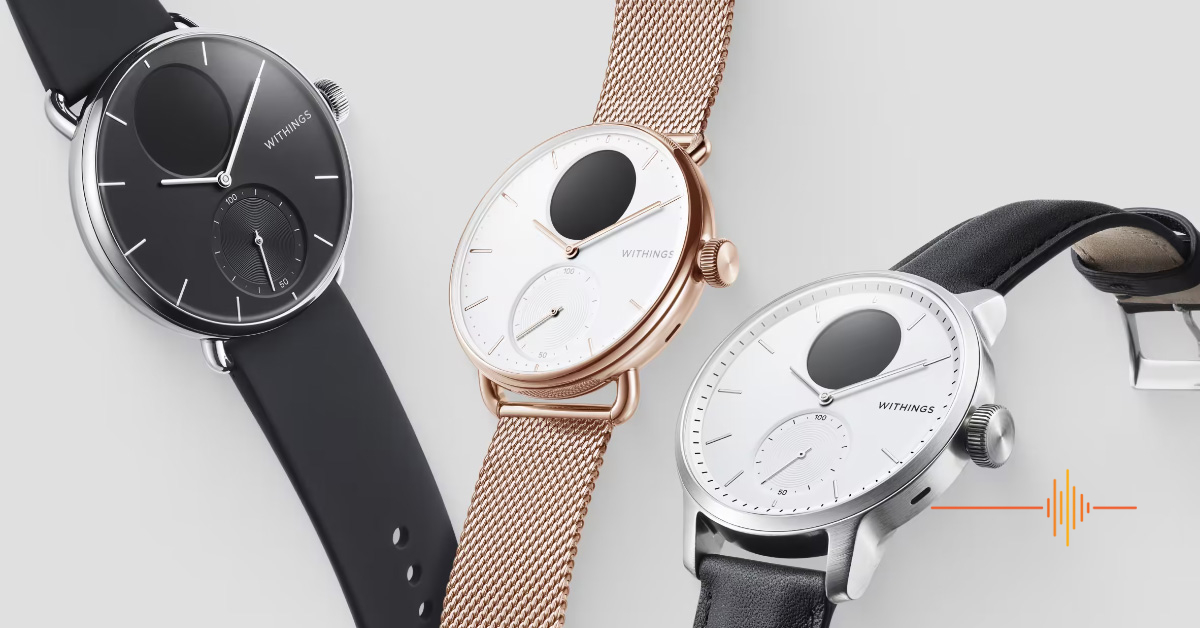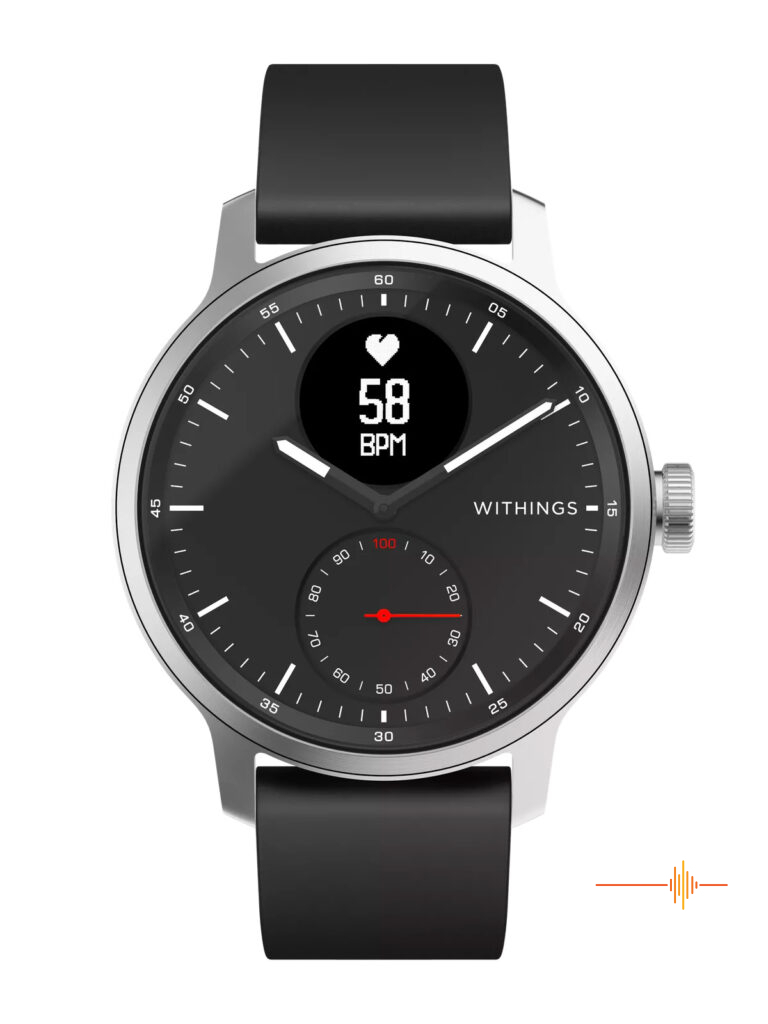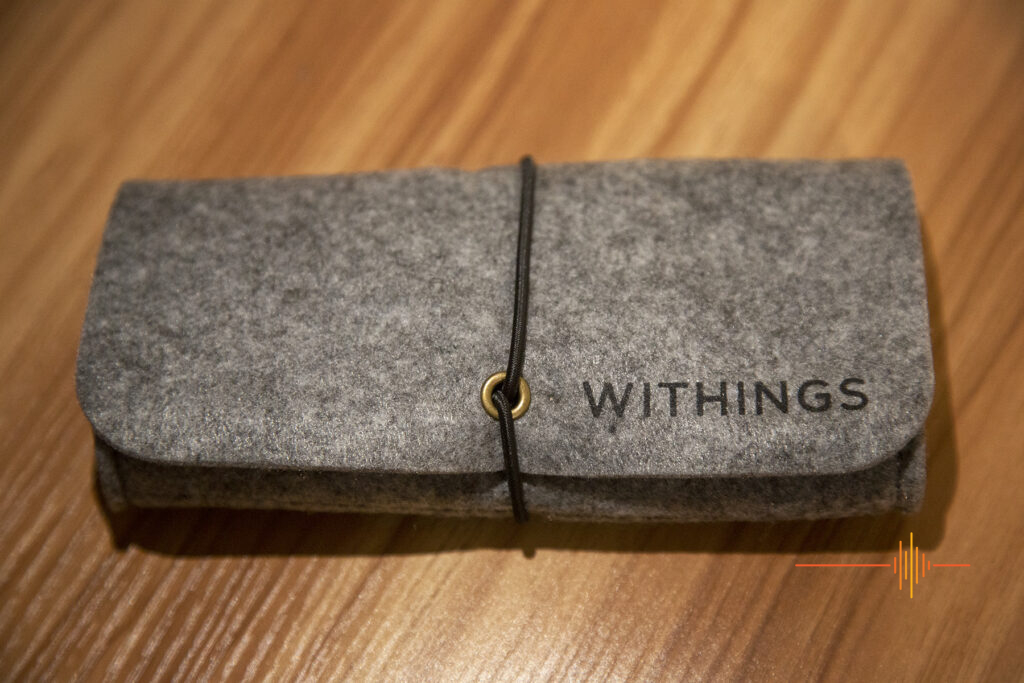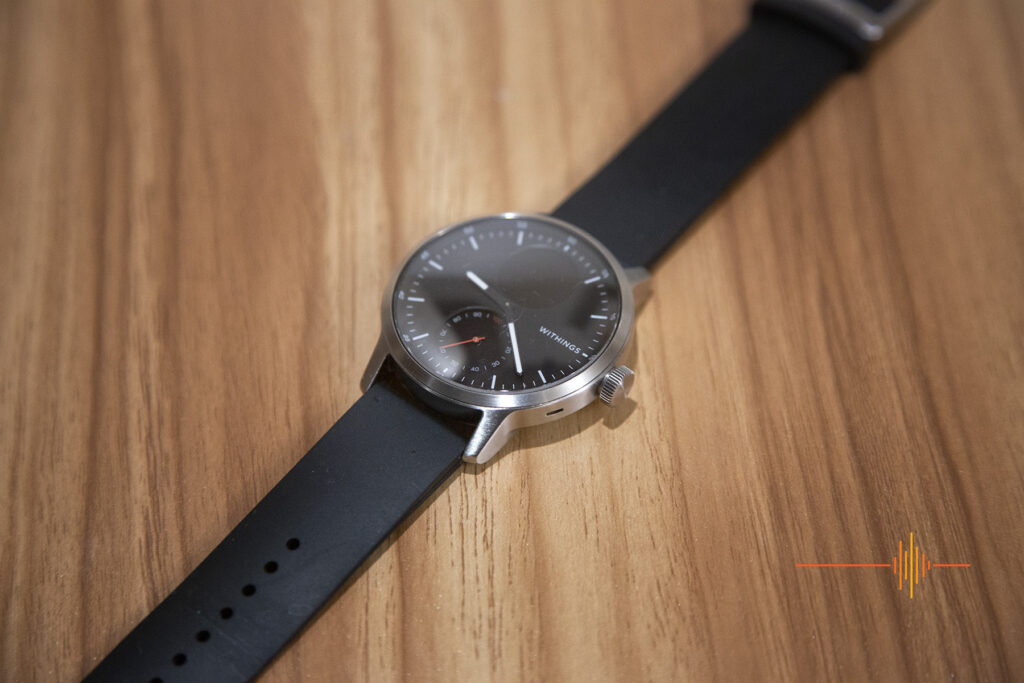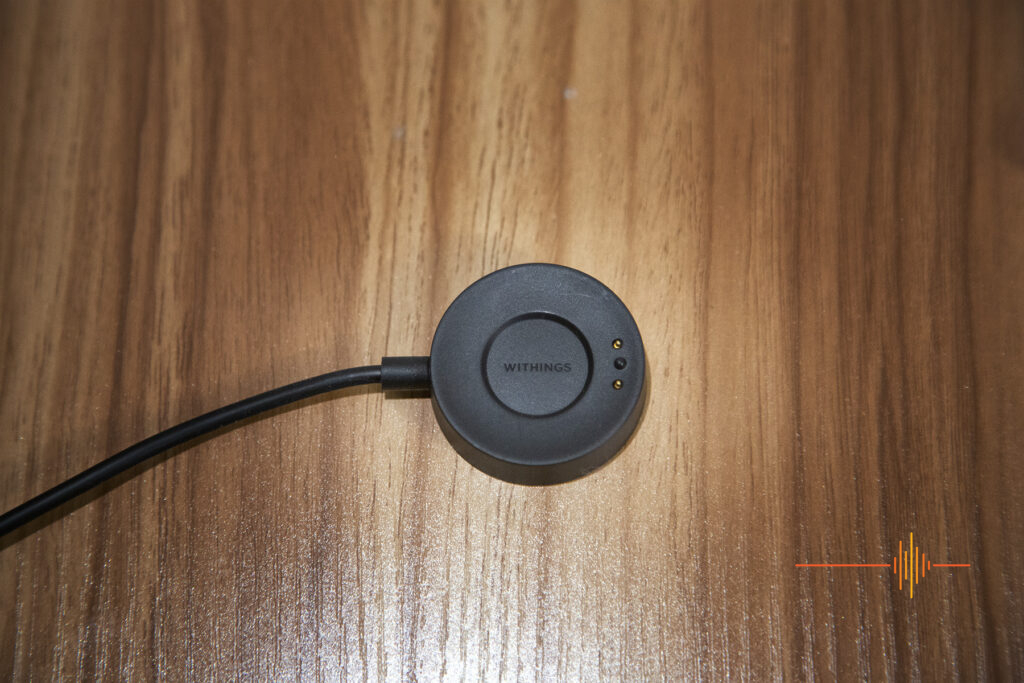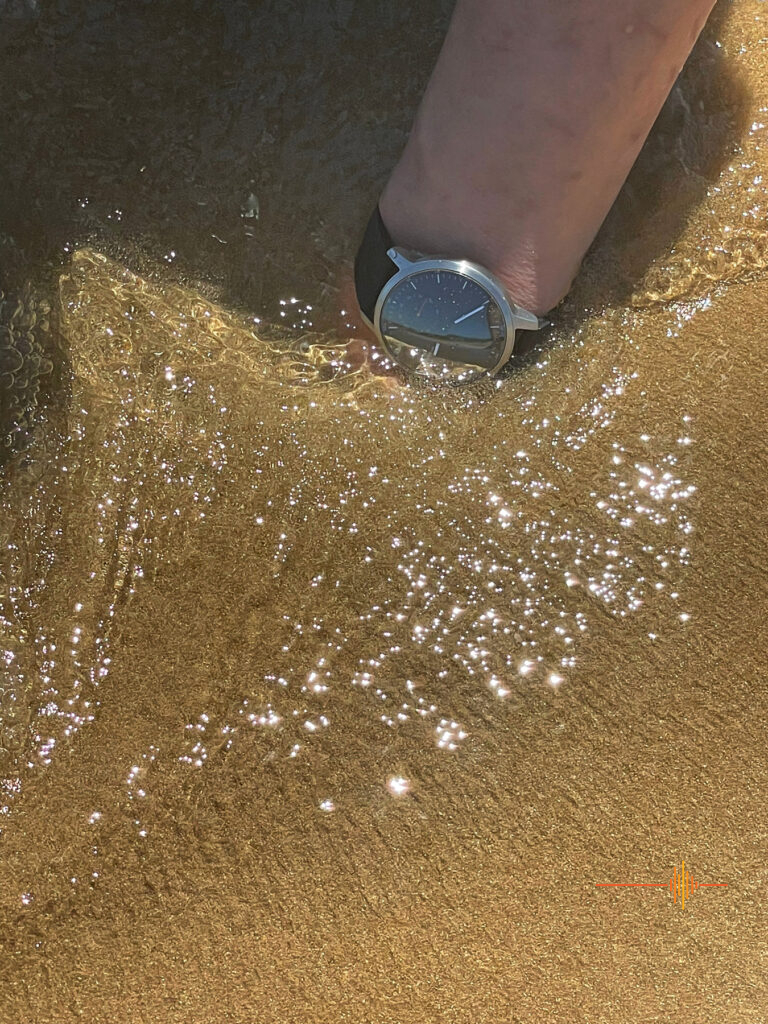The tech world is full of white noise, and those with the most marketing budget generally takes the lead. Withings is a brand that has been floating around the peripherals of my knowledge for a while. When the opportunity came to test the ScanWatch, I didn’t have to be asked twice.
If you are not familiar with the brand, Withings is a French consumer electronics company with roots in the medical field. In 2009 they lead the field of connected devices with the first Wi-Fi scale on the market.
First Impressions
As the saying goes, you only have one chance at making a first impression. The ScanWatch makes a hell of a first impression.
Upon unboxing the product, I was not greeted by the watch front and center under the box cover. Instead I laid eyes on a grey pouch with an elastic around it that holds both the ScanWatch and in a separate compartment, the charger puck. Simple things but this presentation really appealed to me. I am pretty sure the watch will rarely go back in, but with a claimed battery life of 30 days, it is plenty of time to lose the cable if I leave it floating around. Also the three compartments, including two that have a strip of velcros, makes for a great little carry case for my bundle of charging cables.
What sets the ScanWatch apart from the smart watches and activities bands on the market is the hybrid digital and analogue screen. It is a marriage of traditional and modern that is neither awkward or out of place. At a cursory glance the ScanWatch can pass as an ordinary analogue watch and that suits my taste just fine.
The face of the watch has what appears to be two subdials (or auxiliary dials as they are also known as) located in the vertical plane. Withings has made the top subdial a digital display, the bottom is analogue.
Getting Started
I held off jumping off the deep end on this review, only because I wanted to fully charge the device first. It would be remiss of me not to give the battery life a good run.
To get things going, you will have to download the Health Mate app from your smartphone’s app store. I use a Google Pixel so some of the steps I went through before connecting to the ScanWatch will be Android specific. I would imagine that it will be fairly similar on iOS with only minor differences where HealthKit would be in play rather than Google Fit.
First things first, you will need to create an account with Withings (or use your Google account for single sign-on). I am not a fan of authorising my accounts to have cross website access, that is just putting all my eggs in one basket and poor opsec. So yes I would highly recommend creating a separate account.
You will have to agree to the Withings Privacy Policy and a relationship policy with Withings before you can continue. Bearing in mind that this device measures and tracks your health, you need to understand what you are agreeing to.
Of course, your age, sex, height and weight are important information for fitness metrics, so be honest with yourself even if it may be uncomfortable to acknowledge. This is your data and journey, shared with Withings of course and well, Google. There is an option to connect with Google Fit and it will require you to give permissions to link your Withings app to your Google account.
Once you get past these steps, it is time to connect the ScanWatch. The wizard is on point and the bouncing ball is easy to follow. It will take you through all the obligatory Bluetooth connection, checking for firmware updates etc. What happens next was something I wasn’t expecting to see.
As part of the setup and calibration process, all the hands of the watch, including the subdial, are set to the 12 o’clock position. When you tap on the yes to confirm this is the case, the hands are then moved to the correct local time. Seeing the hands on the watch move around caught me by surprised. I wasn’t sure what I was expecting to be fair, and an automated process makes perfect sense. This capability to move the pointers has a definitive purpose, more on this later.
In Use
A small but important step to using the Withings ScanWatch is how to wear the watch. Firstly you need to tell the wizard which side you wear your watch on.
Secondly the wizard points out that the device should be worn with the dial on the outside of the wrist. It baffles me a bit to see people wear watches on the inside of their wrists but apparently it does happen (yeah I am look at you Lis).
Now you are ready to use the ScanWatch in earnest.
You are not abandoned to discover the features on your own. The wizard gives you an overview to navigate around.
With smart watches I like to set the notification settings early in the piece. I know just too well the amount of notifications I get will rapidly take over and it becomes totally useless to me. After much experience with using and reviewing smart watches, I know exactly what I needed turn on to improve my efficiency, and more importantly what to turn off.
The ScanWatch comes with all the minimum features you would expect in a smart watch in this day and age:
- Heart health monitoring
- Sleep analysis
- Activity tracking
But being a device from a company with a medical focus, it also has
- Breathing disturbance tracking
- Atrial fibrillation notification
Diving deeper under the surface, each of these features are more than superficial. The ScanWatch, in combination with the Health Mate app, will track and monitor your health data, this reports can be downloaded via the app and shared directly with your doctor. Withings claims that the ScanWatch boasts a medical-grade ECG and an oximeter for SpO2 measures.
The ScanWatch is equipped with three electrodes to do it’s recordings – two on the back of the case against your wrist, and one being the metal ring around the watchface.
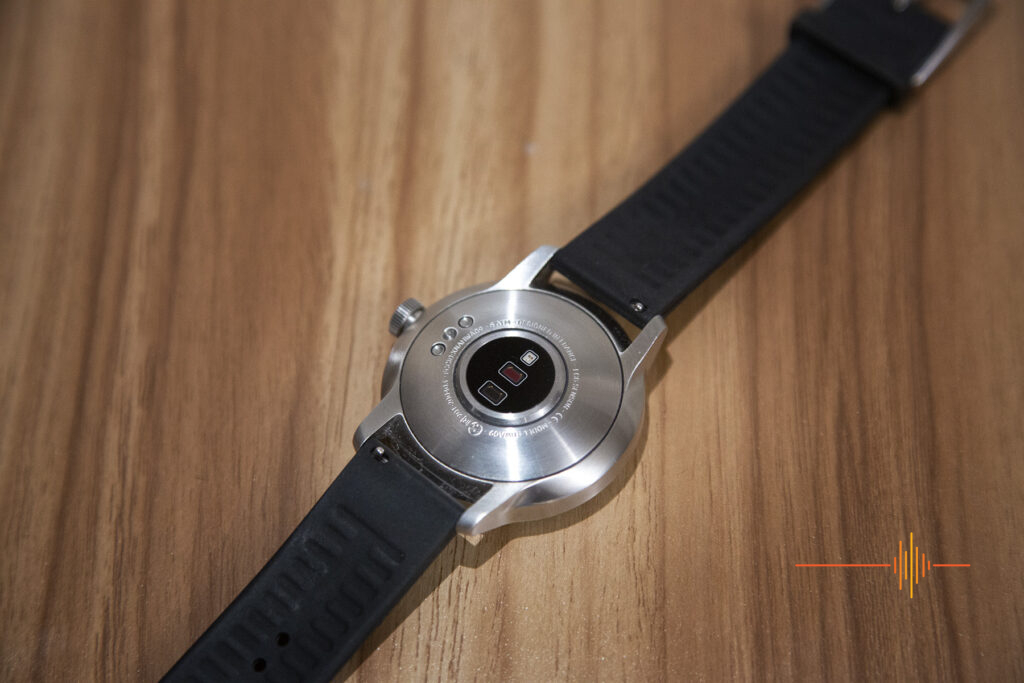
Heart health monitoring
The ScanWatch takes a reading and records your heart rate periodically and will send a notification when it detects arrhythmia. These include situations where the user is experiencing a high or low resting heart rate episode.
The app will then advise the user to record an electrocardiogram (ECG), all done on the watch. The electrocardiogram is claimed to be medical grade which can detect signs of atrial fibrillation. In simple terms, atrial fibrillation is a type of irregular heartbeart (arrhythmia) which can damage your heart and health if left undiagnosed and unchecked.
To record an ECG, whether as for regular recording or instructed to by the app, the ScanWatch can perform the task in 30 seconds. By putting the ScanWatch into ECG mode and placing your finger on the ring, it closes a loop that allows the ScanWatch to measure your heart’s electrical activity using a method called one-lead electrocardiogram.
I found it more reliable to follow the video in the app (or on the webpage) and put my hand over the watch face, relax and wake for the little buzz to tell me that the reading has been taken. Regardless, measurements are periodically taken day and night, and your sleep report includes the average resting heartrate while you are in slumberland.
Sleep Analysis
This is usually the area of a smart watch that I like to dive into with all the enthusiasm of witnessing an impending trainwreck. I tick all the boxes and more for poor sleep candidate.
Late nights? Regularly.
Well under recommended hours of sleep? Without a doubt.
Low periods of restful sleep? I’d debate that.
Low quality sleep? You’d be surprised.
Interrupted sleep? Not that I would agree with.
The last six months has seen some life changing events for me, changes to routine. More demands to be on the ball with timing and routine. I was very morbidly curious to see what the ScanWatch would say about my sleeping patterns.
Not surprising I am regularly charting poor for duration. I mean, less than 6 hours a night is normal right?
Depth? The ratio of light vs deep (restorative) sleep, can be good to bad depending on the night. What was interesting was that I am fairly consistently around 2 to 3 hours of deep sleep per night. That is regardless of my duration of sleep. The ratio is really skewed when I have a short night but because of the deep sleep duration, it is charting as generally positive.
Regularity is hilariously reported as good, because my sleep times are so consistently bad and getting up in time for the school run, it comes back as regular.
Interruptions .. is generally low. I occasionally do have to get up for a toilet break. And I do fall asleep on the couch before getting up to check on the kids and take myself off to bed.
One thing to note. If you immediately check the app for your sleep metrics as soon as you wake up, the data may not be up to date. I have noticed that the results changes a few minutes later when I went back in to recheck my scores.
How accurate is the tracking? I manually track my sleep via Sleep as a Droid which I clock in as reasonably accurate as I note when the phone goes on charge for the night and when I get up. Yes I know you are going to tell me that from when the phone goes on charge is not when I fall asleep, but let me assure you that unless I have something really bothering me on my mind, I don’t have problems falling asleep in minutes. Anyone who’s ever travelled with me can attest to just how fast I can fall asleep in almost any situation.
Doing some quick calculations, the two sets of data are roughly within 4.4 – 7.4% of each other’s readings. There was one night where the ScanWatch clocked almost an hour less than what I did but I will take that as an outlier. Obviously with a manual tracking I have no data on my deep sleep so I can’t compare that data. Short of a full blown sleep study condition, I can work with what the ScanWatch reports back with.
Oxygen Saturation (SpO2)
I think COVID has brought the importance of oxygen saturation to the fore. The horror stories of people who contracted the Alpha strain, shortage of ventilators and oxygen saturation readings have to be closely monitored paints a bleak picture.
Also known as SpO2, oxygen saturation is a measure of the amount of oxygen-carrying haemoglobin in the blood relative to the amount of haemoglobin not carrying oxygen. The body needs there to be a certain level of oxygen in the blood or it will not function as efficiently. Very low levels of SpO2 can result in very serious symptoms with the condition known as hypoxemia.
The ScanWatch boasts a medical grade oximeter which measures your blood oxygen level. A consistent reading below 90 percent is cause to visit your doctor.
Taking a manual reading for Sp02 is same as for ECG. Just set the mode via the dial to the correct menu item and put your hand over the watch face for 30 seconds.
Activity Tracking
ScanWatch claims it will automatically recognise your activity and log it in the Health Mate app. One thing I do like is that the ScanWatch does not try to cater to a million different activities, at least not on the watch face itself. Via the watch there are just five categories and a generic “Others”.
The five categories are:
- running
- swimming
- cycling
- walking
- indoor running
I do want to get more active but other than the chasing after the kids at the park, or walking them to and from school, I would be lucky to have a spare moment for me time. I take solace that I am inherently busy and doing things. The down side is that I never remember to manually log my activities.
The ScanWatch tries to do it for me, but it doesn’t always get it right. In that I mean it doesn’t always log the activities as I don’t do it long enough for it to register. But over a few weekends when I was breaking down pallets into slats, well the activity got logged as cycling.
I mean well, there is cycling in recycling, and there is a cyclic motion to hammering the crowbar in between timber pieces then wedging them apart, but it is not cycling. The point is the ScanWatch takes a stab at it and it is better than nothing. However if you want it to be tracking the activities accurately from the get to, then it is best to remember to manually kick it off yourself.
Even when I logged 16000+ steps and 12.8km distance for the day, Heath Mate only reported 22 minutes of walking at 56m.
Post event though, you can go into it via the Health Mate app and change it reflect the activity better. There is an exhaustive list from Badminton to Zumba to choose from. You can even add a photo to it as a cover. If only we had this kind of tech back when I was playing badminton competitively.
Other Features
It pays to check out the suggestions in the app to check what features are available on the ScanWatch, because not everything is turned on by default. Turning on more features does come with a battery life penalty. More on battery life later, but at my age, it is a no-brainer to keep a closer eye on my health.
I went in to explicitly turn on these features, after reading the instructions for user which pops up automatically the first time you go into these individual settings. it is also important to note that Withings has obtained medical certifications for these metrics, meaning all measurements taken manually are medical-grade and acknowledged by doctors.
Oxygen Saturation is not monitored during sleep unless explicitly enabled, this will help in catching signs of sleep apnea.
Signs of AFib needs to be explicitly enabled, and additionally, notifications for AFib can be turned off so any abnormal detection will only be displayed in app.
You can custom set your daily step goal. By default it is set to 10,000 steps which perpetuates the marketing origins of this benchmark. It isn’t wrong per se but research as shown you can still achieve health benefits from only 7,000 steps a day. So if you are consistently missing the 10k goal, you could set the bar lower to build confidence.
And this brings me to talking about the analogue subdial. This is actually a percentage display of your steps for the day so you can see how you are tracking at a glance. Clever!
Battery Life
Withings rates the watch to have up to 30 days battery life which is impressive compared to competitors. If you look at Apple Watch Series 7, it’s about 18 hours. Google Watch is rated up to 24 hours, Fitbit up to a week. Even taking it with a large grain of salt, the ScanWatch dominates on paper.
Does it live up to the hype? Well after the first 24 hours, with only some of the features on the watch was down 4% from fully charged. Progressively over the review period I have made manual measurements for ECG and SpO2 for testing purposes, it tracks my sleep. The only time I have taken off the watch is for the shower. I don’t have to but it is a personal preference. I have also turned on the AFib and Respiratory Scan features about a week into testing. So 21 days into my review I am down to 6% battery life. So average of about 4.47% a day of battery drain and I should have just under 1.5 days left, taking me to almost 23 days of mixed use which is mighty impressive.
Granted that marketing is one thing, but we are still double what Fitbit markets their battery life. It is certainly impressive.
A USB-A charging puck comes with the device, and it is geared to only work in one direction. There are two gold pins with a guide in the middle.
Health Mate
The ScanWatch and Health Mate app together are truly the sum of the two parts.
Whilst the ScanWatch takes the measurements, the Health Mate does the heavy lifting for your health record.
The home screen of the app displays a summaries of your metrics for the features you have enabled. These include step count, sleep score, SpO2, heart rate, ECG and activities. Scrolling to the bottom you have an at a glance scorecard for each day of the week.
Hitting the plus sign on the top right, you can manually input activities, blood pressure, body temperature, heart rate, nutrition and weight. Needless to say, the more data point you have recorded, the better the profile you can generate.
Scrolling to the second page is the Dashboard which displays similar information but with a more holistic view.
The app offers more information and measurements than what you will see on the ScanWatch. And given the small size of the digital subdial, it is a good thing that Withings limits what information is conveyed on device.
Looking a bit deeper if you are keen to track your progress to a healthier life, Health Mate can share data with popular options such as Strava, Run Keeper for example. It even supports integration with IFTTT and Nest to have automation routines based on your metrics. That’s got to get a gong for thoughtfulness.
Through the app you can also set reminders such as adopting a fixed sleeping habit (yeah that’s not happening with me), or establish a pre-sleep ritual (that’s a great idea in general), or even as simple as drink a hot herbal tea. Afterall tea has lots of antioxidants and is generally healthy.
Reminders spans across multiple categories such as health as mentioned in the above paragraph, weight and nutrition, activities and heart. It is worth browsing through and start the new healthier you with some help.
A Little Quirk and Other Observations
Circling back to the display, the ScanWatch is not a full screen digital device. As noted at the start only one of the subdial is actually a display. Some people may scoff at the size of the display but it is perfectly serviceable to me. In another twenty years I might struggle with reading it but I was pleasantly surprised at how well the information is presented.
For example, the six digits pairing code fits on the subdial in two lines of three digits. Perfectly clear. The digital time and date is displayed without the need for scrolling.
Other notifications will scroll horizontally twice so you can catch all the information.
I was pleasantly surprised to find the hands of the dial are luminous, just like many analogue watches.
This one isn’t a gripe, kind of a feature, but I think it is just quirky. It does take a little getting used to.
If either of the watch hands is traversing across the digital subdial, when you press the button to wake up the screen, the hands automatically moves to 11:11am position to frame the subdial and very nicely frames the information.
But … if you are glancing at the data and reading the clock at the same time, you might just get it wrong. Essentially don’t trust the clock hands when the display is on. Or if it’s Tommy Little telling you the time from an analogue clock, don’t trust him at all! On the bright side, you can turn this off in settings so that the time is always correct.
The default band provided is the Premium Sport Fluoroelastomer Wristband which to me is easier to keep clean and dust free compared to silicone.
Gripes
It’s not so much a gripe but pointing out a missing feature. There is no onboard GPS tracking so you are reliant on your phone. If you are going for a bit of outdoor exercise then you are going to have to carry your phone with you.
On the bright side, you don’t have a battery life penalty for having GPS onboard.
Putting the ScanWatch on charge is less satisfying than I would have prefer, granted that it is quite a period between drinks. I’d have liked a stronger magnet guide to get the watch onto the puck and for the watch to stay on. At the end of the day, a 2 hour charge up every 20-30 odd days is not as problematic as it could be otherwise.
Conclusions
The Withings ScanWatch made a great first impression, and in use it continued to impress.
I love the old school look with the modern functionality blending in without sticking out like a sore thumb. It feels like Withings has managed to achieve a perfect balance between old world and new world, and it is so natural to use.
Like many smart watches, they come in multiple sizes. The ScanWatch is available in either 38mm or 42mm and with some classic colour ways such as Black & Silver, White & Silver, White & Rose Gold and Blue & Rose Gold. Any of these options can easily pass as a dress watch and if that isn’t enough for you, there are options to change the band to other materials such as leather, metal, silicone and more.
The ScanWatch (42mm) is retailing for AUD$374 right now from JB Hi-Fi, Amazon and The Good Guys. Why not start the new year with some health resolutions, at this price point and battery longevity, this is a fantastic option to consider.
Specifications
Dimensions:
38mm model: 38.4mm diameter (1.6’’), 13.2mm thickness (0.52’’), 18mm wristband width (0.70’’), 58g (watch only)
42mm model: 42mm diameter (1.65’’), 13.7mm thickness (0.54’’), 20mm wristband width (0.79’’), 83g (watch only)
Display: Analog dial with hands for hours and minutes. Subdial displays progress toward daily activity goal in percentage. The PMOLED screen displays SpO2, irregular rhythm and smartphone notifications, heart rate, steps, floors climbed, distance, calories, activities, and settings. Workout mode displays timer and heart rate (continuous tracking). Clock menu with alarm, stopwatch and timer. Notifications display previews of incoming calls, text messages, calendar events and 100+ apps.
Battery life: Single battery charge lasts up to 30 days in normal use. +20 additional days in power reserve mode (time and activity tracking only)
Charging time: Approximately 2 hours to 100%. About 1 hour to 80%
Materials: Comes with a stainless steel (316L) case featuring brass lacquered dial with applied chrome indexes, guilloche subdial (except the 42mm black model), chrome hands, sapphire glass, and a soft, durable & water-resistant fluoroelastomer wristband.
Conditions of use: Water resistant up to 165 feet deep (50 m, 5 ATM)
Operating temperature: -10°C to 45°C (14°F to 113°)
Storage temperature: -20°C to 85°C (4°F to 185°)
Pacemakers and implantable cardioverter defibrillators (ICD) can make ECG recordings inconclusive.
Sensors: Exclusive multi-wavelength PPG heart rate/SpO2 sensor. Stainless steel electrodes. High precision MEMS 3-axis accelerometer


